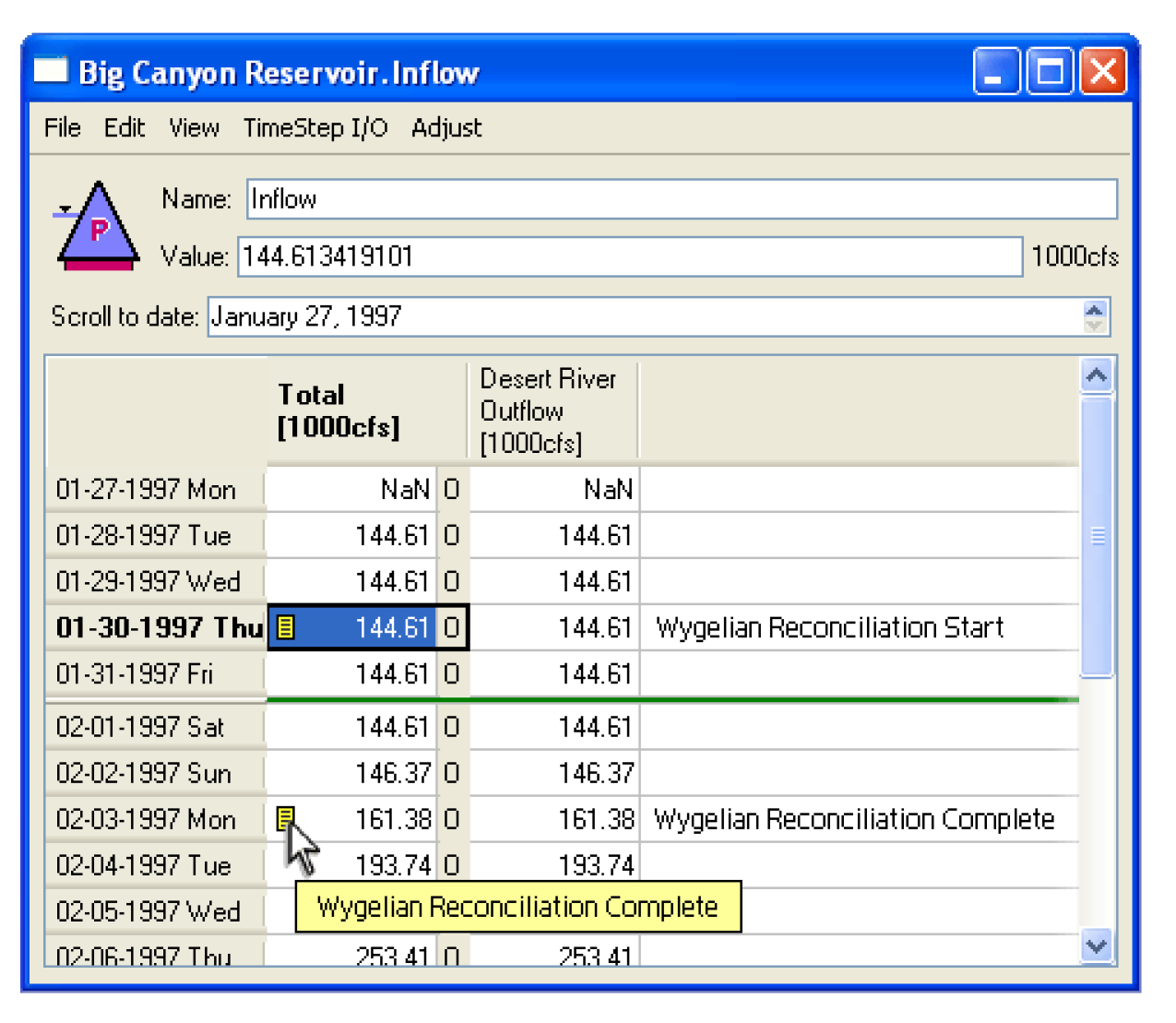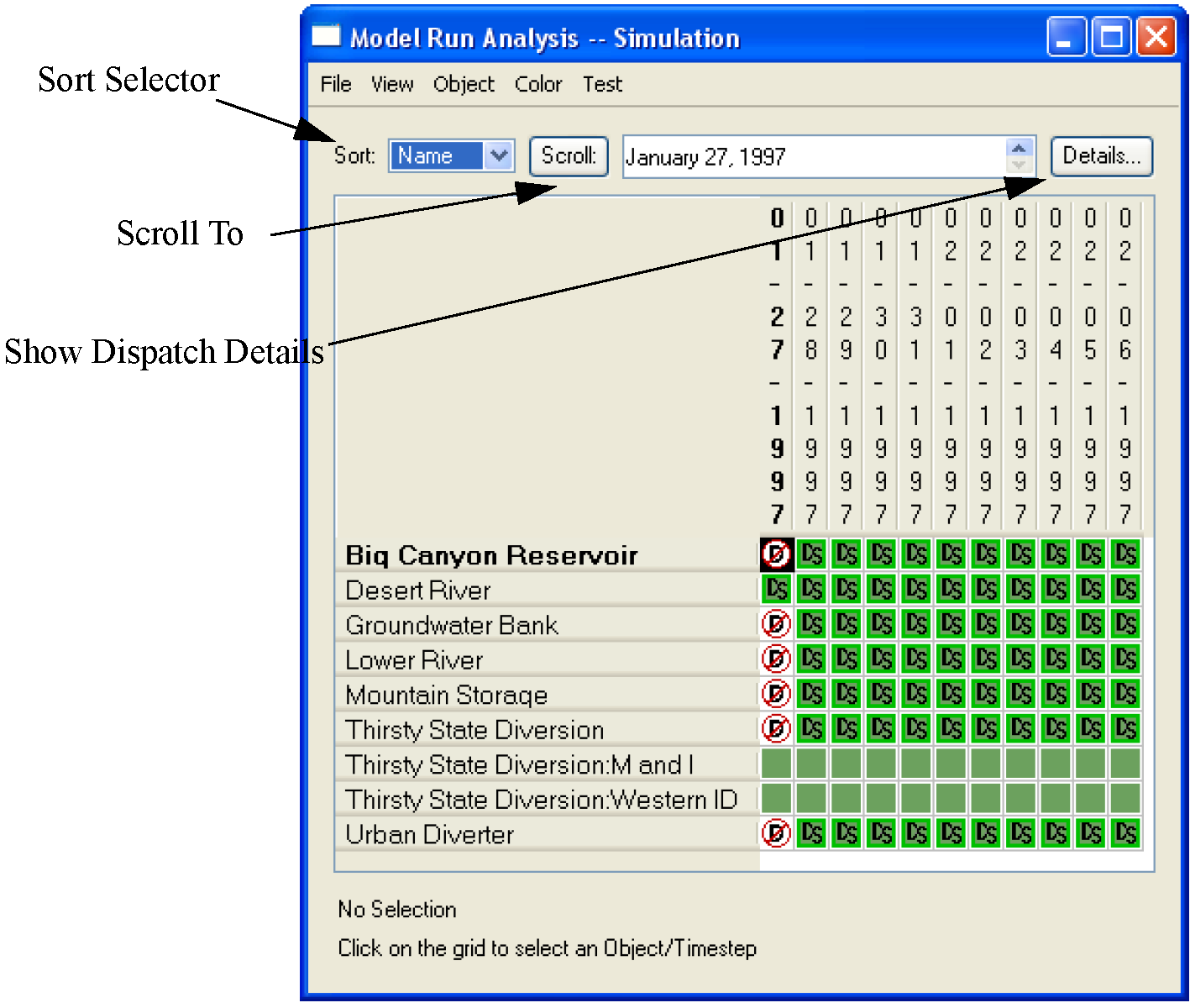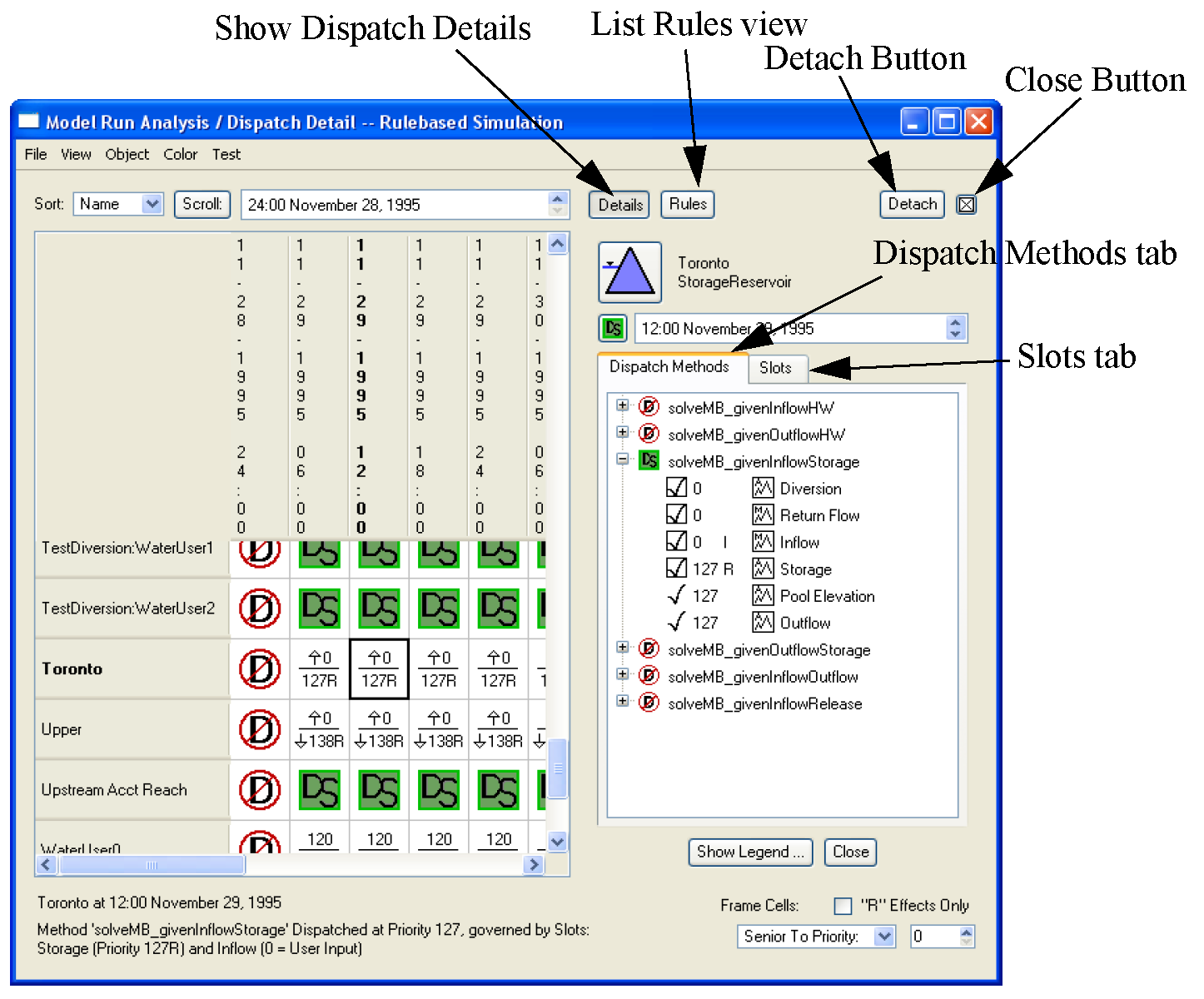General User Interface Enhancements
Slots
Notes on Series Slots
It is now possible to add notes to values in series slots. These can be used to denote when certain operations start, change, or end. The user can see the notes through a tool tip or by configuring to show a column of notes as shown in the following screenshot.

Further information is given in Notes on Series Slots in User Interface.
Slot Adjust Values
One or more values selected in a slot can be adjusted using the “Adjust Values...” item available from the Edit menu of slot dialogs. When the user selects “Adjust Values...” RiverWare opens an Adjust Selected Slot Values dialog which allows the user to provide the amount by which the selected slot values should be adjusted. Values may be adjusted by a percentage, or if all of the values have the same units, by a fixed increment in user units. The user first selects (highlights) the slot values to be adjusted then chooses the “Adjust Values...” option from the Edit menu. In the Adjust Selected Slot Values dialog that appears, the user enters the adjustment value. The user then applies that adjustment value to the selected slot values by selecting the “Ok” button or cancels the adjustment using the “Cancel” button. The dialog automatically closes.

The slot value(s) assure) adjusted by adding a certain amount to the existing slot value(s) or by multiplying the slot value(s) by a percentage. The user may specify a positive or negative quantity. The percentage option adjusts the existing amount by adding a specified percentage of that amount.
For example if the values 10.0 and 100.0 acre-ft/month are selected and the user enters 10 acre-ft/month into the Adjust Slot Values Dialog and selects “Ok”, then the values will be changed to 20.0 and 110.0. If the user enters 10%, the values will be changed to 11.0 and 110.0.
Note that it is easy to select all cells in a column by clicking on the header for that column.
Open Series in SCT
The Open SeriesSlot and Open TableSeriesSlot dialog boxes now support functions to show the series data in a new SCT or add the series data to the single open SCT (enabled only if one SCT is shown).
These functions are accessible from series-data applications of the Open Slot dialog: File SCT Show in New SCT and Add to Open SCT.
Global Time Scroll
A context menu option was added that allows the user to globally scroll the all opened dialogs to a given timestep. On an open slot dialog, the user can right select a timestep in a slot and select Global Time Scroll. Then all open (or previously opened) dialogs that have a timestep will scroll to this timestep. For example, the Model Run Analysis, opened plotting devices, and Open Object dialogs will scroll to that timestep. This operation can be performed from numerous locations in RiverWare including the Open Slot dialog and Model Run Analysis.
Model Run Analysis port to Qt
The Model Run Analysis and its related dialogs were ported to Qt. The dialogs, although similar to the previous version, now have a new look as shown in the following screenshot:

Also noted on the screenshot are some additional features including:
• The objects can be sorted by Name, Type, Position, or Internal order.
• Scroll to Date functionality
• A button to show the Dispatch Details. (This button will open the Dispatch Details in a docked window.)
In addition, the Dispatch Details and List Rules dialogs are now in Qt. These two dialogs can either be shown as stand alone dialogs or docked in the Model Run Analysis as shown in the following rulebased run dialog.
When docked, the dialogs can be separated using the Detach button. When in stand alone mode, the dialogs can be docked from the Dispatch Detail’s File Dock in Model Run Analysis menu. A button is also provided to switch between the Dispatch Dialog and List Rules. Finally, on the Dispatch Detail’s dialog, the Dispatch Methods and Slots view are now on separate tabs.

In the new dialogs:
• “Time on Top” is the only currently implemented configuration
• The font can be changed
• The rules colors can be changed from the color menu
• Pre-simulation and post-simulation timesteps are now shown
On the Model Run Analysis dialog, right-click context menus were added to Show Dispatch Detail, Open the Object, Copy the Time, Global Scroll, and Disable Dispatching.
In the Dispatch Detail dialog, selecting the Object icon brings up the Open Object dialog. Similarly, selecting the icon brings up the Model Run Analysis and docks the Dispatch Detail.
brings up the Model Run Analysis and docks the Dispatch Detail.
 brings up the Model Run Analysis and docks the Dispatch Detail.
brings up the Model Run Analysis and docks the Dispatch Detail.Slot Selector Enhancements
A new filter was added to the slot selector dialogs to filter slots by timestep size. Using this filter, the user can specify to show only slots of a given timestep size.
In addition, the selector was enhanced to show and select by the column name in Series Slots, Table Slots and Table Series Slots. This is appropriate and available, for example, in Database DMI Name Maps where the user can select to import column 2 of an Agg Series Slot. To facilitate functionality, a Column Name filter was added to the selector. In addition, a push button was added to highlight “Columns Only” on the selection. The wildcard toggle also works for this type of selection. A “columns only” toggle was added next to the wildcard toggle to specify that in the wildcard selection, only the columns should be selected and not the overall slot. Following is an example of how this could be used: A user configures 5 agg series slots to contain crop water requirements for 10 different crops. (5 slots * 10 columns = 50 timeseries) When creating a name map for use in importing via the database DMI, the user sets the filter to select each of the columns that are labeled “Crop 1” across the multiple slots. The user can then specify that “Crop 1” maps to “corn” in the database Name Map. This enables the user to set up only 10 Name Maps, one for each crop, instead of the 50 that were previously required. Following is a screenshot of the selector showing these new filters.

Timestep size on SCT
An option was added to allow the user to configure the SCT to display slots at a different timestep from the Run Control. For example, an SCT can be configured to show monthly slots within a daily model. Only one timestep size is allowed per SCT, but multiple SCT’s can be configured with different timestep sizes for a given model.
This feature is configured using a new “SCT Timestep Size Override property” found on the General tab of the SCT configuration dialog.
Revised: 01/05/2024